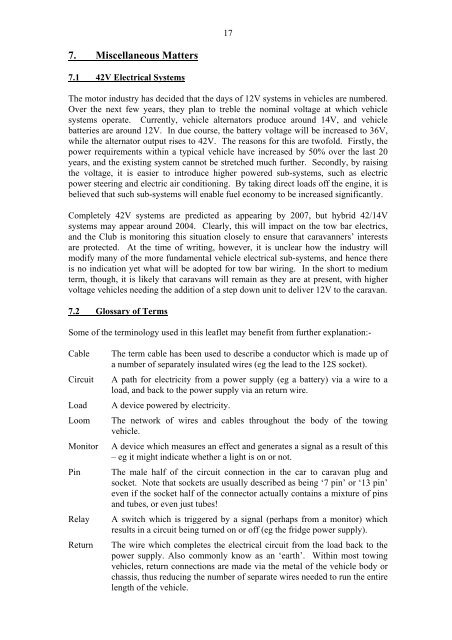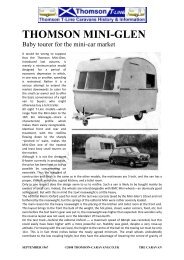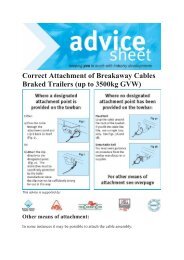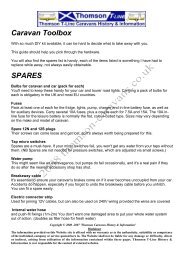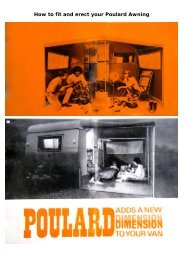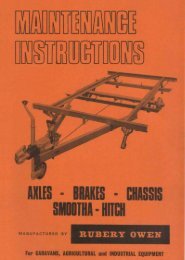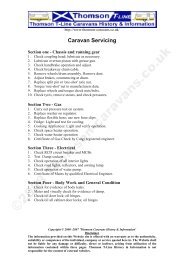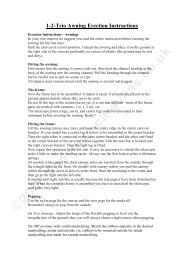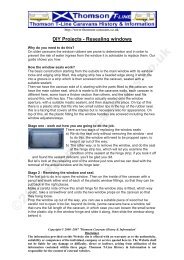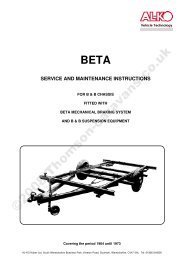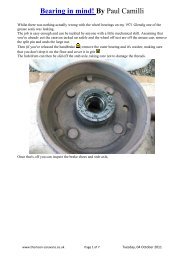Towbar Wiring - Volvo Owners Club
Towbar Wiring - Volvo Owners Club
Towbar Wiring - Volvo Owners Club
You also want an ePaper? Increase the reach of your titles
YUMPU automatically turns print PDFs into web optimized ePapers that Google loves.
17<br />
7. Miscellaneous Matters<br />
7.1 42V Electrical Systems<br />
The motor industry has decided that the days of 12V systems in vehicles are numbered.<br />
Over the next few years, they plan to treble the nominal voltage at which vehicle<br />
systems operate. Currently, vehicle alternators produce around 14V, and vehicle<br />
batteries are around 12V. In due course, the battery voltage will be increased to 36V,<br />
while the alternator output rises to 42V. The reasons for this are twofold. Firstly, the<br />
power requirements within a typical vehicle have increased by 50% over the last 20<br />
years, and the existing system cannot be stretched much further. Secondly, by raising<br />
the voltage, it is easier to introduce higher powered sub-systems, such as electric<br />
power steering and electric air conditioning. By taking direct loads off the engine, it is<br />
believed that such sub-systems will enable fuel economy to be increased significantly.<br />
Completely 42V systems are predicted as appearing by 2007, but hybrid 42/14V<br />
systems may appear around 2004. Clearly, this will impact on the tow bar electrics,<br />
and the <strong>Club</strong> is monitoring this situation closely to ensure that caravanners’ interests<br />
are protected. At the time of writing, however, it is unclear how the industry will<br />
modify many of the more fundamental vehicle electrical sub-systems, and hence there<br />
is no indication yet what will be adopted for tow bar wiring. In the short to medium<br />
term, though, it is likely that caravans will remain as they are at present, with higher<br />
voltage vehicles needing the addition of a step down unit to deliver 12V to the caravan.<br />
7.2 Glossary of Terms<br />
Some of the terminology used in this leaflet may benefit from further explanation:-<br />
Cable<br />
Circuit<br />
Load<br />
Loom<br />
Monitor<br />
Pin<br />
Relay<br />
Return<br />
The term cable has been used to describe a conductor which is made up of<br />
a number of separately insulated wires (eg the lead to the 12S socket).<br />
A path for electricity from a power supply (eg a battery) via a wire to a<br />
load, and back to the power supply via an return wire.<br />
A device powered by electricity.<br />
The network of wires and cables throughout the body of the towing<br />
vehicle.<br />
A device which measures an effect and generates a signal as a result of this<br />
– eg it might indicate whether a light is on or not.<br />
The male half of the circuit connection in the car to caravan plug and<br />
socket. Note that sockets are usually described as being ‘7 pin’ or ‘13 pin’<br />
even if the socket half of the connector actually contains a mixture of pins<br />
and tubes, or even just tubes!<br />
A switch which is triggered by a signal (perhaps from a monitor) which<br />
results in a circuit being turned on or off (eg the fridge power supply).<br />
The wire which completes the electrical circuit from the load back to the<br />
power supply. Also commonly know as an ‘earth’. Within most towing<br />
vehicles, return connections are made via the metal of the vehicle body or<br />
chassis, thus reducing the number of separate wires needed to run the entire<br />
length of the vehicle.


